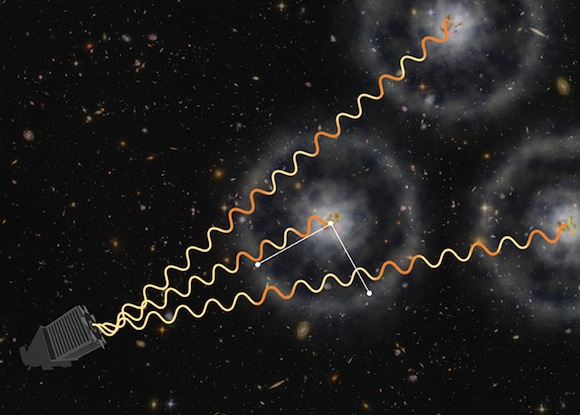
Astronomers from the Sloan Digital Sky Survey have used 140,000 distant quasars to measure the expansion rate of the universe when it was only one-quarter of its present age. This is the best measurement yet of the expansion rate at any epoch in the last 13 billion years.
The Baryon Oscillation Spectroscopic Survey (BOSS), the largest component of the third Sloan Digital Sky Survey (SDSS-III), pioneered the technique of measuring the structure of the young universe by using quasars to map the distribution of intergalactic hydrogen gas. Today, new BOSS observations of this structure were presented at the April 2014 meeting of the American Physical Society in Savannah, GA.
These latest results combine two different methods of using quasars and intergalactic gas to measure the rate of expansion of the universe. The first analysis, by Andreu Font-Ribera (Lawrence Berkeley National Laboratory) and collaborators, compares the distribution of quasars to the distribution of hydrogen gas to measure distances in the universe. A second analysis team led by Timothee Delubac (Center de Saclay, France) focused on the patterns in the hydrogen gas itself to measure the distribution of mass in the young universe. Together the two BOSS analyzes establish that 10.8 billion years ago, the universe was expanding by one percent every 44 million years.
“If we look back to the universe when galaxies were three times closer together than they are today, we’d see that a pair of galaxies separated by a million light-years would be drifting apart at a speed of 68 kilometers per second as the universe expands,” says Font-Ribera.
Delubac explains that “we have measured the expansion rate in the young universe with an unprecedented precision of 2 percent.” Measuring the expansion rate of the universe over its entire history is key in determining the nature of the dark energy that is responsible for causing this expansion rate to increase during the past six billion years. “By probing the universe when it was only a quarter of its present age, BOSS has placed a key anchor to compare to more recent expansion measurements as dark energy has taken hold,” says Delubac.
BOSS determines the expansion rate at a given time in the universe by measuring the size of baryon acoustic oscillations (BAO), a signature imprinted in the way matter is distributed, resulting from sound waves in the early universe. This imprint is visible in the distribution of galaxies, quasars, and intergalactic hydrogen throughout the cosmos.
“Three years ago, BOSS used 14,000 quasars to demonstrate we could make the biggest 3-D maps of the universe,” says David Schlegel (Lawrence Berkeley National Laboratory), principal investigator of BOSS. “Two years ago, with 48,000 quasars, we first detected baryon acoustic oscillations in these maps. Now, with more than 140,000 quasars, we’ve made extremely precise measures of BAO.”
As the light from a distant quasar passes through intervening hydrogen gas distributed throughout the universe, patches of greater density absorb more light. Each absorbing patch absorbs light from the spectrum of the quasar at a characteristic wavelength of neutral hydrogen. As the universe expands, the quasar spectrum is stretched out, and each subsequent patch leaves its absorption mark at a different relative wavelength. The quasar spectrum is finally observed on Earth by BOSS, and it contains the signatures of all the patches encountered by the quasar light. Astronomers then measure from the quasar spectrum how much the universe has expanded since the light passed through each patch of hydrogen.
With enough good quasar spectra, close enough together, the position of the gas clouds can be mapped in three dimensions. BOSS determines the expansion rate by using these maps to measure the size of the BAO pattern at different epochs of cosmic time. These new measurements provide key data for astronomers seeking the nature of the dark energy postulated to be driving the increase in the expansion rate of the universe.
David Schlegel remarks that when BOSS was first getting underway, precision measurements using quasars and the Lyman-alpha forest had been suggested, but “some of us were afraid it wouldn’t work. We were wrong. Our precision measurements are even better than we optimistically hoped for.”











